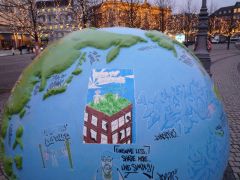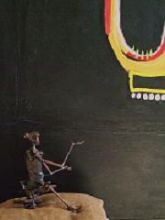FLOP15
… or a political climate change?
Okay, the much heralded Copenhagen agreement as a sustainable solution on climate change has turned out an illusion. Now, what should environmental organizations do? For one thing: count their blessings. For another, redo their homework –better, this time…
It was to be ‘the last chance’ to save human kind and biodiversity. But last December the COP15 Copenhagen conference on climate change did not reach any binding agreement.
Of course, environmentalists widely blame the weak politicians, or the fossil fuel lobby that sabotaged the game. But actually they just had a weak case. What’s more, they failed to acknowledge it and staged an ill-founded hype around COP15.
 Most importantly, the scientists that most vigorously advocated the man-made global warming hypothesis, have not yet been able to deliver conclusive over-all evidence, whatever the dramatic changes in weather patterns in many regions of the world. Yes, permafrost and parts of ice caps are melting. But as to the causes and future developments, many fundamental questions remain.
Most importantly, the scientists that most vigorously advocated the man-made global warming hypothesis, have not yet been able to deliver conclusive over-all evidence, whatever the dramatic changes in weather patterns in many regions of the world. Yes, permafrost and parts of ice caps are melting. But as to the causes and future developments, many fundamental questions remain.
In the eighties, when the climate issue made its first headlines, several important green organizations were looking for new self justification. Their leaders naively targeted the world’s most ruthless industrial sector – fossil fuels – without sufficiently developed scientific data or alternatives.
Activists and scientists got tied up in a mutual self propelling dance of climate PR and lost sight of political reality. So they failed and got a load of scandals about their scientific allies instead.
Nevertheless, Copenhagen did bring a spark of good news – thanks to a new generation of world leaders: for the first time all the major polluting nations did join hands to some degree. Yet, for the near future, innovative industries will be more logical partners than politicians on this issue. Activism and action should focus on proven local and regional climate problems and their sustainable solutions.
Regaining independence and realism are indispensible for both scientists and environmentalists, if any real green climate strategies are to come off.
© Photo: Michel Robles 2009
Martial Art

Once they were bullets, pistols or grenades. Now under the deft hands of Mozambique’s possibly most famous sculptor Goncalo Mabunda they have been transformed into Art.
Recycling AK-47's and other arms from the one-time civil war has become the trade mark of Mabunda and a couple of his fellow artists. I saw some of the results in a small B&B in Antwerp. But even the British Museum and the Bill Clinton Foundation acquired pieces from the 'Arms into Art' programme. Read more…
Photo: © Michel Robles
High on FSC

Ten years ago the Netherlands were an admired environmental pioneer nation. Nowadays, due to a shortsighted neoliberal policy we are almost tail-end Charley within the European Union. Belgium, on the other hand, is a real runner-up. Last December (2010) the Flemish Leukenheide distillery presented Dennenknopje (Pine Bud). Dennenknopje is the world’s very first jenever (traditionally a truly Dutch strong drink), made from a Forest Stewardship Council (FSC) labeled wood product. The gin-like softbooze is distilled from pine cones from the Pinus silvestris. The pines grow in Flanders’ vastest, FSC certified forest region Bosland. A local high from an okay forest. Innovation can be anywhere.…
Questioning Plastiki pride
The newly designed cradle-to-cradle catamaran Plastiki has recently arrived is Sidney after a publicity voyage from California across the Pacific Ocean. The designers claim extreme recyclability. But, contrary to earlier announcements, the ship will not be up-cycled now that it has reached its destination. The builders say they've become too attached to their newborn baby. Of course, the vessel can be a showcase for years to come. But, hey, isn't this kind of attachment of people to their achievements precisely the reason why our earth is becoming such a cluttered place? www.theplastiki.com

Sweet C2C
Cradle-to-cradle handmade beauty: go haunt the town's antique and recycle shops and flea markets for a bunch of elegant (or maybe you prefer funny or modern design) plates, saucers and wine glasses. Wash them well, sand the glasses' brims lightly and glue things together with strong porcelain glue. Any shape, size and design you fancy, will do.


Lo and behold: you have now created your own home grown bonbonnière! For sweets, cookies, fruit - or sandwiches if you like. Ladies love'em! Dozens were sold in a fashion shop in my home town. Enjoy more...

Photos: © Michel Robles
Links
Novio Design Webdesign
